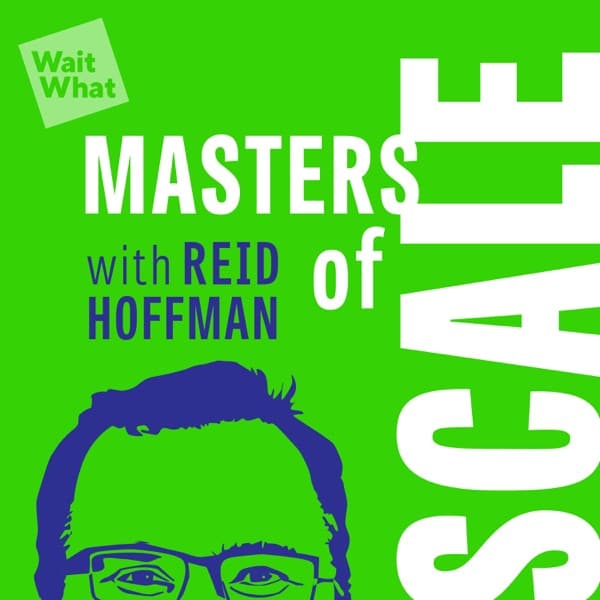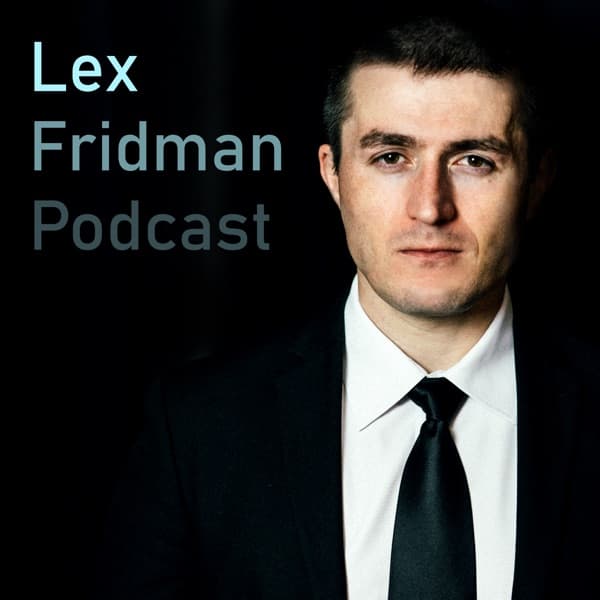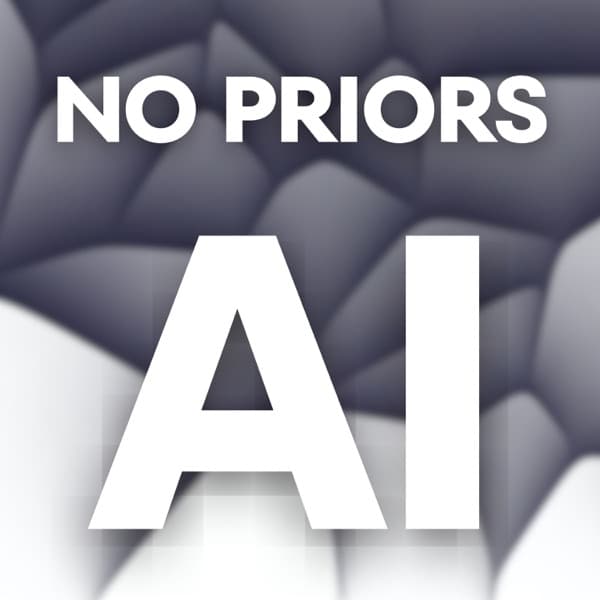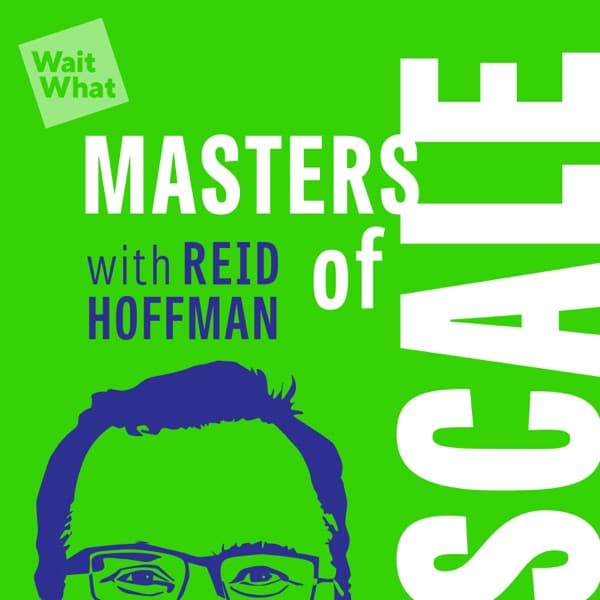a16z: The discussion explores the intersection of AI, crypto, and new technologies, emphasizing the need for new economic models for creative people in an AI-driven world.
How I Built This with Guy Raz: The episode features advice for entrepreneurs from Ariel Kay, founder of Parachute Home, focusing on business growth, risk management, and leveraging unique market positions.
Modern Wisdom: The discussion explores the tension between autonomy and connection in human evolution and modern society, highlighting how these needs impact happiness and social dynamics.
The Twenty Minute VC (20VC): Venture Capital | Startup Funding | The Pitch: McCore, a fast-growing company, raised $100 million at a $2 billion valuation, focusing on automating talent recruitment and leveraging AI models.
Masters of Scale: Atio CRM adapts to your company's workflow, offering AI-powered automation and data enrichment without manual entry.
TechCrunch Startup News: Level Zero Health is developing a continuous hormone monitoring device, aiming to revolutionize hormone tracking and healthcare innovation.
TechCrunch Startup News: Luminance, a legal tech startup, uses AI to automate contract processes and has raised $75 million in Series C funding.
a16z - Who Will Own the Internet? a16z’s Chris Dixon on AI and Crypto
The conversation highlights the convergence of AI, crypto, and emerging technologies, suggesting that these fields complement each other and can lead to innovative economic models for creatives. The speaker emphasizes the importance of open-source systems and decentralized networks to ensure broader community control over AI, rather than a few large companies. Examples include projects like Jensen, which offers a crowdsourced compute layer, and Story Protocol, which uses blockchain to register intellectual property, allowing creators to set terms for usage and revenue sharing. The discussion also touches on the potential disruption of traditional internet models by AI, which could lead to a concentration of power among a few large AI systems, potentially breaking the existing economic covenant of the internet. The speaker advocates for new incentive systems to maintain a diverse and innovative internet landscape. Additionally, the conversation explores the potential of AI to create new forms of media and applications, drawing parallels to historical technological shifts like the rise of film with photography. The need for regulatory frameworks to address AI's impact on jobs and industries is also discussed, emphasizing the importance of maintaining competition and innovation in the tech sector.
Key Points:
- AI, crypto, and new technologies can create new economic models for creatives.
- Open-source and decentralized networks are crucial for community control over AI.
- Projects like Jensen and Story Protocol exemplify innovative uses of blockchain in AI.
- AI could disrupt traditional internet models, concentrating power in a few large systems.
- Regulatory frameworks are needed to address AI's impact on jobs and maintain innovation.
Details:
1. 💡 Embracing AI in Creative Economies
1.1. Economic Models in an AI World
1.2. Adapting Economic Models for AI Integration
1.3. Challenges and Solutions in AI Adoption
2. 🔗 Synergy of Crypto and AI
- Historically, technology advancements often occur in pairs or triples, such as the combination of Cloud, mobile, and social technologies 15 years ago.
- Mobile technology expanded computing access from hundreds of millions to billions of users, showcasing the potential for rapid scalability.
- Social platforms emerged as the killer app by broadly engaging users, demonstrating the importance of application innovation in tech adoption.
- Cloud infrastructure was pivotal in enabling the development and scalability of both mobile and social technologies, highlighting the importance of supportive infrastructure.
- AI and crypto are positioned to similarly reinforce and complement each other within the current tech ecosystem.
- For instance, AI can enhance crypto security through advanced algorithms, while blockchain can improve AI data integrity and transparency.
3. 🌐 Blockchain: Redefining Internet Architecture
- Blockchain is evolving beyond cryptocurrencies to redefine internet architecture, offering unique benefits in decentralization and security.
- The control of AI by a few companies raises concerns, underscoring the importance of open-source initiatives to democratize AI technology.
- Despite a trend towards open-source AI, many systems have become closed, limiting transparency and reproducibility, often justified by safety concerns but possibly driven by business interests.
- Projects like llama, flux, and Mr aim to preserve open-source principles in the AI ecosystem, though their openness remains vulnerable.
- The lack of open data pipelines in AI models challenges reproducibility, indicating a need for more transparent practices.
- Significant investments are being made in internet services tailored for AI, promoting open services across different layers, enhancing the accessibility and scalability of AI technologies.
- Jensen exemplifies a project developing a crowdsourced compute layer, enabling startups to extend their compute capabilities beyond their infrastructure, similar to the Airbnb model, fostering innovation and accessibility.
4. 🎨 Democratizing Creative Rights with Blockchain
- Story Protocol offers a novel method for registering intellectual property on the blockchain, enabling creators to securely register works like images, videos, or music.
- The system mirrors existing copyright laws and is designed for international application, ensuring blockchain records reflect legal agreements.
- Creators can define usage terms, including permissions for remixes or derivative works, and set revenue-sharing conditions such as a 10% royalty on generated revenue.
- This protocol creates an open marketplace, simplifying compliance with creators' terms without needing complex negotiations.
- Such democratization of creative rights management challenges traditional models, which often favor large companies like the $100 million OpenAI-Shutterstock deal.
- The protocol enhances accessibility for individual creators, allowing them to protect and monetize their work globally with ease.
5. 🧩 Composability: The Future of Creative Collaboration
- Composability is a driving force behind open-source software's exponential growth, boosting its market share from 0% to over 90% since the 1990s.
- The concept facilitates collective enhancement, mirroring Wikipedia's model of collaborative knowledge sharing.
- In media, composability enables creative collaboration, allowing for the remixing and expansion of elements like characters and stories, akin to Lego blocks.
- Generative AI can utilize composability to create new creative works by integrating existing elements, like inventing a new superhero universe.
- Composability's success hinges on seamless integration of contributions and aligned financial incentives.
- In blockchain, composability enhances the ability to create and integrate decentralized applications, fostering innovation and interoperability.
6. 🎭 New Economic Models for Creatives in AI Era
- Encourage creatives to embrace new AI tools by developing economic models that support them in an AI-driven world.
- Traditional social networking companies retain 100% of revenue from content created by users, suggesting a need to shift towards models where creators can set upfront payments and benefit from increased composability.
- Crowdsourced model evaluation is emerging as a method to gather more data, leveraging crypto to design new incentive systems for data collection and model evaluation.
- The integration of new incentive systems with AI systems can enhance data quality and availability, critical for AI development and creativity.
7. 🔒 Enhancing Digital Identity with Blockchain
- Worldcoin, co-founded by Sam Alman, is addressing identity verification challenges in an AI-driven world by leveraging blockchain technology.
- Initially, Worldcoin used an orb to scan users' eyeballs, a method that faced controversy and privacy concerns.
- To improve user acceptance and address privacy issues, Worldcoin now offers alternative identity verification methods using passports to create a cryptographic identity proof on the blockchain.
- This blockchain-based identity verification provides a secure and universal identity solution that can be used across various platforms, enhancing both security and usability.
- Current CAPTCHA systems are increasingly ineffective and complex, while blockchain solutions offer a more secure and user-friendly alternative.
- Blockchain technology provides a way to verify identity without compromising user privacy, addressing the limitations of traditional verification methods.
8. 🧠 Decentralizing AI Control
- Decentralizing existing AI systems, both in code and services, can unlock new capabilities such as machine-to-machine payments.
- Exploring new business models in a decentralized AI framework presents exciting opportunities for innovation.
9. 🌍 AI's Impact on Internet Economics
- Historically, the internet's success relied on a decentralized incentive system, encouraging participation from billions without central authority.
- An economic covenant existed between platforms (like social networks and search engines) and website creators: platforms could crawl and index content, directing traffic back to the sites.
- Traffic from platforms enabled websites to generate revenue through ads or subscriptions, forming the backbone of internet economics.
- Google's 'one boxing' approach, displaying content directly in search results, breached this covenant by reducing clicks to original content sites.
- AI technologies are now challenging this model further by changing how platforms interact with content creators, potentially altering the flow of traffic and revenue.
- Specific AI-driven changes include more sophisticated content summarization and direct response generation, which could bypass traditional click-through models entirely.
10. 🤔 Rethinking Internet Incentives and Structures
- AI systems trained on internet data are now disrupting the traffic and monetization model for content creators by providing direct answers, potentially reducing website visits.
- The rise of three to five dominant AI systems threatens website diversity, similar to the limited TV channels of the 1970s, which could stifle innovation and new website creation.
- The discussion highlights a lack of conversation around AI's impact on internet structures, emphasizing risks to small businesses and startups.
- Concerns are raised about the concentration of internet control in a few AI platforms, suggesting it could break existing internet incentives and harm the ecosystem.
- The need for a dialogue on alternative models and solutions for sustaining diverse internet structures is implied.
11. 📱 The Convergence of AI, Crypto, and New Hardware
- The convergence of generative AI, cryptocurrency, and emerging hardware platforms is reminiscent of the transformative wave of mobile, social, and cloud technologies, each reinforcing the other to create new opportunities.
- Generative AI is playing a critical role in enhancing the capabilities of new devices like AR and VR glasses, which are at the forefront of bringing AI applications into everyday use.
- The development of self-driving cars and humanoid robotics, as seen with companies like Tesla, marks the early integration of AI into practical applications, suggesting a significant potential for innovation in various industries.
- Cryptocurrency technologies provide decentralized and secure transaction frameworks, which are increasingly being integrated with AI systems to handle complex data exchanges and enhance security.
- Emerging hardware platforms, such as advanced AR and VR devices, are leveraging AI to deliver immersive experiences, indicating a shift towards more interactive and intelligent consumer technology.
- The synergy between AI advancements and hardware platforms is unlocking new application possibilities, driving the evolution of sectors like automotive, entertainment, and personal technology.
12. 📶 Crypto's Role in Building Physical Networks
- Helium, a community-owned crowdsourced Telecom Network, competes with major providers like Verizon and AT&T by using an incentive system that allows anyone to set up a helium node at home, significantly reducing costs to about $20 a month compared to traditional $70 plans.
- The use of crypto in Helium helps overcome the network bootstrap phase, a common challenge in network building, by effectively creating incentive systems that encourage widespread participation.
- Crypto-based incentive systems are particularly beneficial in physical networks, including applications in climate modeling, self-driving car data mapping, electric car charging, and decentralized science.
- These decentralized networks are able to scale without the need for traditional massive capital investment, providing a model for building infrastructure in various fields.
13. 📊 Disruptive Business Models through AI
- AI's role as a core versus peripheral component in business models is crucial; incumbents thrive with AI as an add-on ('frosting'), while newcomers excel when AI necessitates new structures.
- Current trends indicate a transitional phase, with no clear advantage for incumbents or newcomers, signaling an ongoing shift in the AI business model landscape.
- Clay Christensen's theory of disruption is pivotal, highlighting that innovation misalignment with incumbent models challenges adaptation despite threat recognition.
- AI-driven shifts, such as those undermining traditional database architectures, exemplify how AI can fundamentally disrupt established industries.
14. 🔄 The Stages of AI Integration
- Current AI technologies in consumer markets are not benefiting significantly from network effects due to low switching costs and overestimated data network effects. For instance, products like chatbots lack the competitive advantages seen in other tech domains.
- To overcome this, companies could leverage brand strength and persistent memory features to create stronger competitive positions. An example would be an AI tool that integrates deeply with users' daily routines, such as calendar applications, fostering user dependency.
- A strategic approach for new entrants is to use AI tools as initial hooks to attract users, then build a community or network around these tools. This is encapsulated in the strategy: 'come for the tool, stay for the network.'
- The current AI landscape is dominated by established players, posing challenges for startups to gain market share. However, there is potential for differentiation through innovative integration with emerging technologies such as cryptocurrency.
- Exploring the convergence of AI with other evolving technologies could offer novel methods for building networks, potentially altering competitive dynamics and offering new market opportunities.
15. 🚀 AI's Evolution from Traditional to Novel Applications
- Technologies typically evolve through two stages: initially enhancing existing processes ("old things better") and subsequently enabling entirely new possibilities ("new things you couldn't do before").
- Steve Jobs' concept of 'skoric' illustrates how referencing past designs can make novel technologies more relatable, smoothing the transition from traditional to innovative applications.
- Native applications illustrate innovations that provide capabilities not previously possible, such as AI-driven personalized medicine, which tailors treatments to individual genetic profiles, a feat unattainable before advanced AI and genomic data integration.
- The evolution of technology leads to second-order effects, exemplified by the invention of cars leading to the development of suburbs and logistics networks like trucking, which were unimaginable before automobiles.
- The impact of technological advancements is often underestimated, as seen by the unforeseen consequences like traffic jams following the invention of cars, highlighting the need for strategic foresight.
- Examples of novel technologies include Bitcoin and social networking, which represent platforms that could not have existed in earlier eras, demonstrating how new technological infrastructures enable unprecedented possibilities.
- Token communities, resembling religious movements, showcase how digital platforms create spaces for congregation and interaction, a concept unachievable before the advent of social media and digital communication networks.
- AI's role in creating smart cities is another novel application, integrating IoT devices and data analytics for efficient urban management, showcasing AI's ability to orchestrate complex systems previously impossible to manage effectively.
16. 🔍 Emerging Media and AI Creativity
- AI is systematically replacing human jobs in sectors such as customer service through AI voice and chatbots, offering a more cost-effective and efficient alternative. This phase is expected to displace tens of millions of jobs, particularly in white-collar sectors, over the next 20 years.
- The initial phase of AI adoption mirrors the early internet era of the 1990s, focusing on enhancing convenience by translating offline processes to online formats, but not yet creating new paradigms.
- Despite initial job displacement, AI holds the potential to create new job opportunities in the future. The next phase of AI will likely involve innovative forms of media and interaction, similar to the emergence of social networking in the 2000s, which could lead to the establishment of new industries and roles.
17. 🎬 From Photography to Film: AI's Creative Transformation
- AI is driving the creation of new media products, akin to how photography laid the groundwork for film, revolutionizing artistic expression.
- The evolution of digital platforms illustrates technology's transformative impact, similar to how Facebook evolved from a digital yearbook to a multifaceted social network.
- Historical parallels suggest AI could redefine creative industries, much like photography did for art, by introducing new modes of storytelling and media consumption.
- AI's influence on film includes the use of machine learning for special effects, enabling more realistic and innovative visual experiences, reducing production time and costs.
- AI-driven editing tools are enhancing post-production processes, allowing filmmakers to experiment with new storytelling techniques and styles.
18. 🌌 AI as a New Canvas for Artistic Expression
- Photography led to a split in art, with Fine Art becoming more abstract while film emerged as a new art form.
- Film was the native media form in the age of mechanical reproduction, similar to how AI is now a base layer for new art forms.
- AI is seen negatively by some as a cheap replacement for human creativity, but positively as a new canvas for creating unprecedented art forms.
- Potential new art forms with AI include virtual worlds, games, and new types of films and media consumption interfaces.
- The excitement lies in using AI to push creative boundaries and achieve things never possible before, similar to the impact of film.
- Historically, new technologies like photography have unlocked more creative opportunities than they have taken away.
19. 🔄 Exploring AI's Second Order Effects
19.1. Emergence of New AI-Driven Behaviors and Applications
19.2. AI's Role in Social Networking Evolution
19.3. Unpredictable Social Movements and AI
20. ⏳ The Role of Human Creativity in AI's Advancement
20.1. The Role of Human Creativity in AI's Advancement
20.2. Examples of Human Creativity Influencing AI
20.3. Case Studies of AI Integration
21. 🏛️ Navigating Regulation and AI's Societal Impact
21.1. Emerging AI Legislation and Challenges
21.2. Philosophical and Industry Impact
21.3. AI in Regulated Industries and Future Considerations
22. 🌐 Envisioning the Internet's Decentralized Future
- In the 90s, money flowed to the edges of the network, benefiting small businesses and entrepreneurs, whereas today, it flows to the center, dominated by a few large companies.
- The top five internet companies hold more than half of the market cap, indicating a concentration of power and wealth.
- Current internet architecture favors control and centralized money flow, potentially leading to a future where five companies control the internet.
- These companies have reached a scale where user growth is limited, leading them to create systems that trap users and stifle competition.
- To counter this, the development of new internet services using decentralized architectures like blockchains is crucial.
- Open source AI and software are essential for startups to build competitive services without paying high costs to incumbents.
- Regulatory policies should encourage competition and innovation to support small tech companies.
- Raising awareness and discussions about these issues are necessary to prevent a future dominated by a few companies.
- The innovation and benefits we enjoy today are products of past startup efforts, which are at risk if current trends continue.
- Decentralized technologies such as blockchain present a viable path to redistributing power and fostering innovation.
- Specific examples include decentralized finance (DeFi), which allows financial transactions without traditional banks, and blockchain-based platforms that enable peer-to-peer interactions and reduce dependency on central entities.
How I Built This with Guy Raz - Advice Line with Ariel Kaye of Parachute Home (August 2024)

The episode provides insights into managing business growth and risk, featuring Ariel Kay, founder of Parachute Home. Ariel discusses her journey from starting a direct-to-consumer brand without prior experience to becoming a leader in affordable luxury home goods. She emphasizes the importance of taking calculated risks and knowing when to pivot or focus on core products. Ariel shares her experience with introducing new product lines, like furniture, and the challenges faced, such as supply chain issues and market fit. She advises entrepreneurs to be comfortable with risk but also to recognize when to focus on their strengths.
The episode also includes advice for callers seeking guidance on business challenges. One caller, Dane Brown, co-founder of King Brown Pomade, discusses his dilemma of being stock-rich but cash-poor and considers seeking investment. Ariel suggests leveraging non-strategic capital to hire expertise in distribution and marketing. Another caller, Deanna Blasi-Diandino, founder of Mindset Tapestry, seeks advice on gaining press coverage without a PR budget. Ariel recommends using affiliate marketing and reaching out to influencers and editors directly. The episode highlights the importance of storytelling and leveraging unique market positions, especially for women in male-dominated industries.
Key Points:
- Take calculated risks and know when to pivot or focus on core strengths.
- Leverage non-strategic capital to hire expertise in areas like distribution and marketing.
- Use affiliate marketing and direct outreach to gain press coverage without a PR budget.
- Emphasize storytelling and unique market positions, especially for women in male-dominated industries.
- Focus on building a strong brand identity and staying true to core values.
Details:
1. 🌟 Early Access and Hosting with Airbnb
1.1. Wondery Plus Benefits
1.2. Airbnb Hosting Opportunities
2. 🎨 Elevate Your Projects with Canva
- Canva enhances professional goals by using visual communication effectively, offering tools that cater to both small and large companies.
- Utilizing Canva's extensive media library, users can significantly improve document presentation with high-quality images and charts.
- The addition of animations through Canva makes presentations more engaging and visually appealing.
- Canva's user-friendly design platform is accessible, supporting teams of various sizes, from two to 2,000 members, in creating compelling content.
- The platform facilitates time-saving and boosts productivity in workplaces by streamlining the design process.
- By making design enjoyable, Canva empowers employees to love their work, ultimately enhancing job satisfaction.
- Case studies have shown that using Canva can reduce project completion times and increase the impact of visual communications.
3. 📧 Engage Customers with Attentive
- Attentive helps marketers create unique messages for every subscriber, transforming the consumer shopping experience and maximizing marketing performance.
- Attentive's AI learns what subscribers want based on their real-time interactions with the brand.
- The platform customizes the content, tone, and timing of every message to ensure they resonate with recipients.
- Attentive's personalized approach has shown to increase customer engagement by tailoring messages to individual preferences, thereby enhancing brand loyalty and driving sales.
- Examples of success include a 30% increase in click-through rates and a 20% uplift in conversion rates following the implementation of Attentive's AI-driven messaging.
- Brands leveraging Attentive have reported a significant boost in customer satisfaction, with personalized messages leading to a 25% improvement in customer feedback scores.
4. 📚 Dive into the Advice Line with Guy Raz
- Ariel Kay provides actionable strategies for business growth by sharing her experience as the founder of Parachute Home.
- Listeners can apply her insights on scaling businesses effectively, particularly in the home goods industry.
- The episode is a favorite from the archive, indicating its valuable and impactful content.
- Ariel emphasizes the importance of understanding customer needs and adapting products accordingly, which is crucial for scaling.
- She discusses the role of strong brand identity and customer loyalty in driving business success.
- Ariel shares metrics from Parachute Home's growth, illustrating the effectiveness of her strategies.
5. 🛏️ Ariel Kay's Journey to Parachute Home
- Ariel Kay founded Parachute Home in 2013 without prior business experience and has since become a leader in affordable luxury home goods, highlighting her adaptability and vision.
- Initially inspired by direct-to-consumer brands like Warby Parker, Ariel strategically expanded Parachute's product line to include bed sheets, towels, rugs, pillows, and mattresses, establishing both an online presence and physical stores.
- Ariel made a significant career transition from advertising to entrepreneurship, despite lacking knowledge in textiles or manufacturing, exemplifying a strategic pivot that led to her success.
- Facing initial challenges such as securing quality manufacturing partners and understanding supply chain logistics, Ariel leveraged her marketing skills to build brand recognition.
- The strategic decision to open physical stores allowed Parachute Home to differentiate itself in the market, enhancing customer experience and brand loyalty.
6. 🔄 Navigating Risks and Growth in Business
- Introducing a new product line, such as furniture, requires strategic risk management. Testing viability should last about a year, as demonstrated by a case where logistical challenges and low margins led to scaling back operations.
- Furniture introduction posed significant supply chain and delivery challenges, impacting overall business operations and profitability.
- Business leaders must embrace calculated risks, understanding that not all ventures will succeed. Flexibility and adaptability are crucial for informed decision-making.
- The example of furniture underscores the importance of assessing logistical and margin-related challenges before full-scale implementation.
- By analyzing outcomes and learning from failures, companies can refine strategies and improve future product launches.
- This approach is part of a broader strategy to balance experimentation with sustainable growth, ensuring that failures provide valuable insights without jeopardizing the business.
7. 📈 Strategic Decisions for Business Evolution
- The Boston Beer Company's experience illustrates the necessity of accepting certain levels of risk to foster growth, even if it results in unsuccessful product launches.
- Leaders must maintain a balanced risk profile, continuing to embrace risks post-failure to drive innovation and growth.
- Businesses need to strategically focus on core strengths and ensure an excellent end-to-end customer experience, especially when conditions are not conducive to high-risk ventures.
- Strategic decision-making requires oscillating between being risk-tolerant and concentrating on core products, guided by market conditions and internal assessments.
- Exploring new opportunities with minimal investment can be a strategic method to manage risk while pursuing innovation.
8. 📞 Insightful Business Advice Calls
8.1. Current Business Situation and Challenges
8.2. Future Strategies and Opportunities
9. 💇♂️ Exploring Hair Care Market Opportunities
- The hair care market presents significant opportunities as it becomes a focus for investors, with increasing interest in innovative products.
- Hair care regimens vary widely, indicating a diverse market with potential for targeted product development and personalized solutions.
- Hair is a key part of personal identity for many, suggesting strong consumer demand for specialized care products.
- The beauty sector, including hair care, is rapidly growing, attracting investor excitement and potential for high returns in this category.
10. 🎁 Innovative Marketing Strategies for Growth
10.1. Introduction to Deanna's Product
10.2. Product Description and Origin
10.3. Market Potential and Strategic Opportunities
10.4. PR and Marketing Strategies
10.5. Influencer and Social Media Engagement
11. 💬 The Power of Affirmations and Gratitude
11.1. Collaborative and Strategic Marketing
11.2. Educational Engagement and Community Targeting
11.3. Targeted Outreach and Authentic Brand Positioning
11.4. Daily Affirmations and Gratitude Practices
12. 💡 Entrepreneurial Wisdom and Lessons
- Babson College has been ranked number one in entrepreneurship for 31 years by U.S. News and World Report, offering graduate programs that equip students with practical skills and a global network to turn ideas into reality.
- Amazon One Medical Pay-Per-Visit provides transparent, upfront healthcare services, allowing for 24-7 provider connection without the need for insurance or scheduling, and includes fast, free medication delivery from Amazon Pharmacy.
13. 🍹 Overcoming Challenges in the Beverage Industry
- Palm Folly, a hard seltzer craft brewery in Florida, uses a unique brewing process with fruit purees instead of grains, making it gluten-free and similar to a craft beer, differentiating itself from typical soda water and vodka-based hard seltzers.
- Megan, the founder, operates largely alone with a head brewer, and their product is available on draft in about 60 locations in Florida and Alabama.
- Megan seeks capital to expand but faces gender bias in the industry, noting that less than 2% of funding goes to women, which affects her interactions with male investors.
- Ariel Kay advises using Megan's unique perspective as a woman to her advantage, leveraging her understanding of the female consumer base in a male-dominated market.
- Megan's product has gained traction locally, hinting at its potential for broader appeal, with her current strategy involving engaging directly with her community through a tap room.
- Ariel and Guy emphasize that the quality and uniqueness of Megan's product can speak for itself and help overcome gender-based obstacles in securing investment.
14. 🌟 Staying True to Brand Values
- Always being true to the core values of your brand is crucial, despite being tempted by new opportunities or trends.
- Testing new strategies is important, but it's essential to constantly return to the brand's core principles.
- Understanding why customers originally fell in love with the brand is key to maintaining authenticity.
- Reflecting on past decisions can reveal areas for improvement in staying aligned with brand values.
- Using the brand's core values as a guiding 'North Star' ensures consistent brand identity.
15. 🎙️ Reflecting on Entrepreneurial Journeys
15.1. Entrepreneurial Vision and Engagement
15.2. Production and Team Contributions
15.3. Listener Engagement and Feedback
15.4. AI Impact on Marketing
Modern Wisdom - #905 - William von Hippel - Why Modern Life Can Feel So Empty

The conversation delves into the evolutionary roots of human needs for autonomy and connection, explaining how these needs have shaped human behavior and societal structures. Historically, humans evolved to prioritize connection for survival, forming tight-knit groups for protection and cooperation. However, autonomy also developed as individuals needed to stand out to be chosen as coalition partners or mates. This dual need creates a tension, as pursuing autonomy often means sacrificing connection. In modern society, this balance has shifted towards autonomy due to urbanization, wealth, and technological advances, leading to increased individualism and a decline in social connections. This shift has contributed to widespread feelings of isolation and dissatisfaction, despite material comforts. The discussion suggests that small, habitual changes in daily life, such as integrating social activities into routine tasks, can help rebalance these needs and improve well-being.
Key Points:
- Humans evolved with a need for both connection and autonomy, creating a tension between these needs.
- Modern society leans towards autonomy due to urbanization, wealth, and technology, reducing social connections.
- This shift contributes to feelings of isolation and dissatisfaction despite material wealth.
- Small, habitual changes can help rebalance connection and autonomy, improving happiness.
- Understanding evolutionary roots can provide insights into modern psychological and social issues.
Details:
1. 📚 Catching Up and New Book Insights
1.1. Episode Context and Catching Up
1.2. Book Themes and Historical Reflection
2. 🤔 Understanding Wealth and Happiness Discrepancy
- Living standards are at an all-time high, yet many people report feeling unhappy, indicating that material wealth does not equate to happiness.
- A study by Princeton University found that beyond an annual income of $75,000, additional income does not significantly increase happiness, highlighting a plateau effect in the wealth-happiness relationship.
- Despite the availability of modern conveniences, there is a persistent dissatisfaction, suggesting that comfort does not directly translate to emotional well-being.
- The irony of being upset over trivial matters while living in luxury points to a disconnect between financial status and perceived happiness.
- Exploring diverse perspectives, some psychologists suggest that meaningful relationships and personal growth contribute more to happiness than wealth.
- The narrative underscores the importance of shifting focus from material wealth to emotional and mental health to bridge the happiness gap.
3. 🌿 Lessons from Hunter-Gatherer Societies
- The disparity between wealth and happiness is highlighted, as modern individuals often have more resources but not necessarily greater happiness compared to hunter-gatherer societies.
- Hunter-gatherer societies endured severe hardships, such as losing nearly half of their children, yet they maintained a level of happiness comparable to, or even greater than, modern societies.
- Modern comforts and safety measures do not guarantee increased happiness, indicating a fundamental disconnect between material possessions and emotional well-being.
- Practical advice like expressing awe and gratitude can enhance momentary happiness, but they don't solve the broader issue of happiness disparity in affluent societies.
- To improve happiness, individuals might focus on cultivating appreciation and gratitude, thereby potentially closing the gap between wealth and emotional fulfillment.
4. 🌍 The Balance Between Autonomy and Connection
- Despite significant economic growth, with incomes tripling in the US and Western Europe over the last 50 years, average happiness levels have remained flat, illustrating the Easterlin paradox.
- The Easterlin paradox highlights that increasing wealth does not necessarily correlate with increased happiness.
- Investigations in Tanzania with the Hadza people revealed over 90% happiness, contrasting with less than 50% happiness in Poland, suggesting that modern conveniences do not equate to higher happiness.
- The disparity in happiness between hunter-gatherer societies and modern societies suggests that simpler lifestyles may lead to greater satisfaction despite more difficult living conditions.
- The Easterlin paradox implies that beyond a certain point, wealth does not significantly increase happiness, which suggests a need to focus on social and psychological factors.
- A clearer understanding of the reasons behind this paradox could guide policymakers in improving societal well-being without solely focusing on economic growth.
5. 🔄 Evolutionary Perspectives on Social Needs
- Humans evolved a fundamental need for connection after leaving the trees and moving to the savannah, crucial for safety and cooperation among social animals.
- Connection enabled humans to cooperate and rise to the top of the food chain, becoming apex predators.
- Simultaneously with the development of the need for connection, humans also developed a need for autonomy, including self-governance and choosing one's own life path.
- Autonomy is essential for standing out as a coalition partner or mate selection, driven by evolutionary motives for survival and gene propagation.
- There is a fundamental tension between the need for connection and autonomy, which impacts human satisfaction and social interactions.
- In modern society, the balance between connection and autonomy can be observed in workplace dynamics where teamwork is essential, yet individual contribution is highly valued.
- Studies show that individuals who effectively manage this balance tend to have higher job satisfaction and better social relationships.
- Example: In a team setting, those who can assert their autonomy while maintaining strong connections tend to be more successful, illustrating the evolutionary balance of these needs.
6. 🏙️ Modern Challenges and Solutions for Connection
- Modern society's focus on autonomy often undermines connections, as individuals prioritize personal desires over relational duties, contrasting with ancestral societies where connection was essential for survival.
- The abundance of choices today has led to an imbalance, with autonomy often prioritized over connection, despite humans evolving to pursue autonomy for its historical rarity and value.
- Excessive focus on personal goals can lead to isolation, as shown by high achievers who feel unfulfilled without strong social networks, highlighting the need for balance between autonomy and connection.
- Hunter-gatherer societies valued reputation, cooperation, and social bonds over individual achievements, emphasizing connection for communal survival.
- Urbanization, wealth, and technology have increased autonomy but weakened community ties, as cities offer more opportunities for personal pursuits.
- Despite digital interconnectedness, modern society experiences irony as people feel more isolated due to fewer genuine, face-to-face connections.
- Balancing competence and warmth is crucial; while competence aids individual success, warmth and connection are essential for being valued in a group.
- Small habitual changes, like shared activities or regular communication, can maintain social bonds without sacrificing autonomy.
- Understanding human social behavior evolution helps address isolation by emphasizing community and shared experiences.
The Twenty Minute VC (20VC): Venture Capital | Startup Funding | The Pitch - 20VC Exclusive: Mercor Raises $100M at a $2BN Valuation: Scaling to $70M in ARR in 24 Months | 9-9-6: 9AM-9PM - 6 Days Per Week: The Most Intense Culture in Silicon Valley | The Future of Programming, Models and Data with Adarsh Hiremath

McCore, a rapidly expanding company in Silicon Valley, recently secured a $100 million funding round at a $2 billion valuation, led by Felicis. The company has achieved significant milestones, including reaching $70 million in ARR within 24 months and being recognized for its intense work culture, with founders who are Teal fellows. McCore's platform automates the recruitment process, connecting exceptional talent with companies, and is particularly focused on leveraging AI models to enhance hiring efficiency. The founders, who have a background in debate, emphasize the importance of selecting the right team and maintaining a strong company culture as they scale. They also highlight the role of human data in improving AI models, suggesting that expert human input is crucial for advancing AI capabilities. McCore's growth strategy includes expanding its talent pool globally, with a significant presence in the US and India, and focusing on building network effects to sustain its business model. The company aims to create a unified labor marketplace, facilitating seamless hiring processes for companies worldwide.
Key Points:
- McCore raised $100 million at a $2 billion valuation, focusing on automating recruitment with AI.
- The company achieved $70 million ARR in 24 months, emphasizing a strong work culture.
- Human data is crucial for AI model improvement, requiring expert human input.
- McCore's platform automates the hiring process, enhancing efficiency and scalability.
- The company aims to build a global unified labor marketplace, leveraging network effects.
Details:
1. 🚀 McCore's Milestone: $100M Funding at $2B Valuation
1.1. Funding and Growth
1.2. Valuation and Market Position
2. 🌐 Diverse Model Ecosystem: Future of AI Applications
- Numerous application layer companies are utilizing AI models for specialized use cases, highlighting a trend towards diversity in AI applications.
- Industries such as healthcare, finance, and retail are increasingly adopting tailored AI solutions, demonstrating the flexibility and specialization of modern AI technologies.
- The shift towards a diverse model ecosystem allows for more precise and effective solutions, addressing specific industry challenges and improving operational efficiency.
- For example, in healthcare, AI is being used for predictive analytics in patient care, while in finance, it's applied to fraud detection and personalized banking services.
- This trend towards specialized models not only optimizes performance but also fosters innovation by enabling companies to focus on niche areas.
3. 🔍 Recruiters: The Backbone of Talent Management
- Recruiters are pivotal in managing talent inflows and outflows, directly impacting a company's strategic operations.
- The role of recruiters is prestigious, highlighting their crucial position in aligning talent with company goals.
- Recruiters implement strategies to attract and retain top talent, crucial for maintaining a competitive edge.
- Case Study: After implementing a targeted recruitment strategy, Company X improved their employee retention by 30%.
4. 🔗 Network Effects: Key to Success in a Zero-Cost Software Era
- Businesses thriving in a nearly zero-cost software environment effectively leverage network effects to gain a competitive advantage. Network effects occur when the value of a product or service increases as more people use it, making it a critical factor for success.
- Examples of network effects include social media platforms like Facebook, where each new user increases the value of the network for all users. This principle is also evident in marketplaces like eBay or Amazon, where more buyers attract more sellers, and vice versa.
- Companies can implement network effects by fostering communities, encouraging user-generated content, or creating platforms that facilitate interactions among users.
5. 🎙️ Inside McCore: An Interview with Co-Founder Adarsh Hayamath
5.1. Funding and Valuation
5.2. Revenue Growth
5.3. Work Culture
5.4. Founders and Innovation
6. 📈 Empowering Creators and Global Teams with Kajabi and Remote
- Kajabi customers have collectively generated $8 billion in total revenue, showcasing the platform's effectiveness in driving significant financial outcomes for creators.
- Kajabi users retain 100% of their earnings, with the average creator earning over $30,000 annually, highlighting the platform's potential for profitable creator ventures.
- Kajabi offers an all-in-one suite of tools for $69 per month, including websites, email marketing, digital products, payment processing, and analytics, providing a comprehensive solution for digital entrepreneurs.
- The platform supports building private communities, writing paid newsletters, and launching courses without taking a revenue cut, allowing creators to maximize their income potential.
- A user case study could illustrate how specific strategies within Kajabi led to measurable success, such as increased course enrollment or community engagement.
- Testimonials from creators who have exceeded their financial goals using Kajabi could further validate the platform's impact.
7. 💡 Founding McCore: From Dev Shop to Global Platform
7.1. Kajabi and Remote Solutions
7.2. Debate Skills and Founding McCore
7.3. Building the Business and Decision to Drop Out
7.4. Scaling and Culture
7.5. AI Models and Future of Work
8. 🏗️ Scaling McCore: From Culture to Rapid Growth
8.1. Sales Process and Customer Acquisition
8.2. Automation in Hiring Process
8.3. Quality Over Price
8.4. Talent Location and Market Insights
8.5. Future of Programming and Software Development
9. 🌐 SaaS Evolution: Replacing Services End-to-End
- The next era of SaaS will focus on replacing entire services, such as end-to-end processes of recruiting agencies.
- SaaS is not dead; instead, it is transforming to automate manual and repeatable services.
- Companies may not build their own software but will adopt SaaS solutions that offer comprehensive service replacements.
10. 🔄 Leveraging Network Effects in Talent Marketplaces
- Mercore's platform gains strength from network effects similar to Uber's labor marketplace model, where each new company and candidate enhances the marketplace's value by expanding the pool of exceptional candidates.
- A crucial network effect is the data flywheel which predicts optimal candidates for roles by analyzing performance data, thus improving the hiring process's efficiency.
- Building platform stickiness and switching costs is vital for sustaining and growing revenue, aiming for a $50 million benchmark.
11. 💬 Decision Making and Cultural Insights at McCore
11.1. Quality and Revenue Insights
11.2. Automation in Hiring
11.3. Remote Work vs. In-Person Dynamics
11.4. Product Development Lessons
11.5. Fundraising Strategy and Success
12. 💰 Strategic Fundraising: Building Financial Strength
12.1. Recent Funding Round and Financial Performance
12.2. Strategic Partnerships and Investor Relations
12.3. Financial Strategy and Future Plans
13. 🕵️♂️ Prestige of Recruitment: Finding the Right Match
- Recruitment is considered the highest prestige position in any company due to its control over talent inflows and outflows, directly impacting company success.
- Despite its importance, recruitment is often underrated and undervalued, leading to inefficiencies.
- Finding the right person for the job is crucial for optimizing efficiency on a per human basis.
- The matching problem in recruitment is significant, requiring strategic solutions to align talent with company needs.
- Effective recruitment not only enhances operational efficiency but also influences company culture and long-term performance.
14. 🤔 Reflections on Leadership and the Future of Work
14.1. Athletic Drive in Leadership
14.2. Shift in SaaS Perspective
14.3. Personal Habits and Efficiency
14.4. Challenges in Building a Business
14.5. Technological Curiosity and AGI
14.6. Vision for Mercor in 2035
14.7. Productivity Tools and Platforms
14.8. Global Team Management
14.9. Financial Solutions for Startups
Masters of Scale - A more compassionate capitalism, with Cotopaxi’s Davis Smith

Atio is a customer relationship management (CRM) system designed to align with your company's unique processes rather than forcing you to adapt to its structure. It leverages AI-powered automation to streamline complex business processes, allowing teams to focus on scaling their business. The system automatically organizes contacts, syncs calendars, and enriches data, eliminating the need for manual data entry. This approach not only saves time but also enhances productivity by reducing administrative burdens. Atio's adaptability and automation capabilities make it a forward-thinking solution for businesses looking to optimize their CRM processes.
Key Points:
- Atio CRM aligns with your company's workflow, not the other way around.
- AI-powered automation handles complex processes, freeing up team resources.
- Automatic contact organization and calendar syncing reduce manual tasks.
- Data enrichment occurs without manual entry, enhancing data quality.
- Focus on scaling business by reducing administrative burdens.
Details:
1. 🌟 Atio: The Future of CRM
1.1. Atio CRM Features
1.2. Atio CRM Benefits
2. 🎉 Masters of Scale Summit 2023
- The Masters of Scale Summit is scheduled for October 7th through 9th at the Presidio Theater in San Francisco.
- The event will feature visionary founders, world-changing executives, and impactful investors.
- The audience is carefully selected for maximum impact, ensuring a unique energy and atmosphere.
- Applications for attendance are currently open, emphasizing the exclusivity and opportunity to engage with influential figures.
- Interested participants should apply at mastersofscale.com/apply25.
3. 🛠️ Cotopaxi's Origins and Unique Business Model
- Cotopaxi initially used remnants and leftover materials to quickly produce backpacks for a 24-hour adventure race, establishing a practice of utilizing salvaged fabrics.
- The company embraced unique, bold color combinations in their products, leading to the creation of one-of-a-kind bags, which became a signature aspect of the Cotopaxi brand.
- The uniqueness of each bag, reflecting the personality of individual sewers, contributed to a remarkable customer satisfaction, as evidenced by a return rate of nearly zero.
- Over a decade, Cotopaxi has gained a strong reputation among outdoor enthusiasts, highlighting the success of their distinctive business model and product offerings.
4. 🚀 From Setbacks to Success: Lessons from Brazil
- Cotopaxi operates as a B Corp and dedicates 1% of its revenue to not-for-profits fighting poverty, aligning with its core mission of social justice.
- David Smith's personal values, including his faith, directly influence the business model of Cotopaxi, emphasizing conscious capitalism.
- David Smith is currently taking a sabbatical to serve his church in Brazil, demonstrating the integration of personal beliefs and professional commitments.
5. 💡 Navigating Business Challenges and Growth
- Davis attempted to launch a baby e-commerce business in Brazil after being inspired by diapers.com and its founder, Mark Laurie. However, the venture was fraught with challenges.
- The Brazilian market was in its nascent stages for e-commerce, presenting both opportunities and difficulties for new entrants.
- Davis faced significant obstacles due to Brazil's complex bureaucracy and his lack of Portuguese language skills, highlighting the importance of understanding local business environments and regulations.
- This experience taught Davis the necessity of anticipating unforeseen challenges when entering new markets, especially in foreign countries.
- This early business venture underscored the critical need for thorough market research and adaptation to local conditions, which are essential for successful international business expansion.
6. 🔍 Efficiency and Scaling: Key Business Insights
6.1. Growth Achievements
6.2. Scaling Challenges
7. 💔 Navigating Personal and Professional Loss
- Prioritize finding a strong business idea before selecting a co-founder to ensure alignment on goals.
- Choose a co-founder who complements the business needs rather than based on personal relationships.
- The optimal co-founder may not be a close friend or family member, such as a brother, cousin, or spouse.
- Emotional impact of a co-founder breakup can be significant, affecting both personal and professional realms.
- Use examples or anecdotes to illustrate the outcome of mismatched co-founder relationships.
- Consider the long-term implications of a co-founder choice on business success and personal well-being.
8. ✨ Epiphany and Birth of Cotopaxi
- The idea for Cotopaxi emerged during a personal crisis while living in Brazil, where the founder was grappling with a failing business and relationship.
- Inspired by a desire to help people, rooted in missionary experiences in Bolivia, the founder spent 36 hours conceptualizing Cotopaxi.
- The vision included creating colorful backpacks and using the business model to enact social good, driven by encountering poverty firsthand.
- The founder described the experience as a profound epiphany, likening it to divine intervention, and meticulously documented the entire conceptual process.
- The founder realized that previous life challenges were necessary to develop the skills and insights needed for launching Cotopaxi.
9. 🌋 Inspiration and Branding: Cotopaxi and the Llama
9.1. 🌋 Inspiration and Branding: Cotopaxi's Inception and Investor Influence
9.2. 🌋 Personal Inspiration and Brand Development
10. 📈 Union Market's Exponential Growth
- Union Market has experienced exponential growth since opening 10 years ago, establishing itself as a key player in the local economy. Recognized for its innovative approach to retail, the market has attracted a diverse range of vendors, increasing foot traffic by 60% over the past five years. The implementation of strategic partnerships and local community events has further enhanced its appeal, resulting in a 45% increase in annual revenue.
11. 🎧 Recommended Listening: Pivot Podcast
- Pivot Podcast, hosted by Kara Swisher and Scott Galloway, provides sharp insights and bold predictions on tech, business, and politics.
- The podcast airs every Tuesday and Friday, offering updates on major stories of the week.
- Listeners can expect engaging discussions and occasional humorous banter, making it both informative and entertaining.
12. 🚀 Innovative Launch Strategy for Cotopaxi
- The founding team for Cotopaxi was assembled by reaching out to award-winning outdoor product designers on LinkedIn, who were inspired by the vision of using profits for poverty alleviation.
- The company was launched with a unique marketing strategy involving llamas and a 24-hour adventure race event on college campuses, generating significant buzz and engagement.
- During the launch event, participants engaged in outdoor adventures and community service to earn points, and the event resulted in 30,000 social media posts in 24 hours.
- The event culminated in a celebration with 5,000 participants, all wearing Cotopaxi products, which significantly boosted brand visibility and engagement.
13. 💼 Persistence in Fundraising and Venture Success
- The speaker engaged with approximately 1,000 investors, highlighting the necessity of broad networking and outreach strategies in successful fundraising efforts.
- Despite facing frequent rejections, maintaining resilience and a strong belief in their mission were critical factors in continuing their fundraising journey.
- Key investments were secured from influential figures like Kirsten Green from Forerunner Ventures and the founders of Warby Parker and Harry's, underscoring the importance of targeting strategic investors.
- The speaker's approach involved leveraging personal networks and focusing on investors who aligned with their vision, demonstrating the value of personalized engagement and strategic targeting in fundraising.
14. 🌍 Cotopaxi's Mission and Global Impact
- Cotopaxi's mission is to eradicate extreme poverty in our lifetime, inspired by the historical reduction from 94% in 1820 to under 10% today.
- The company aims to demonstrate that business can be a force for good and that capitalism can be improved to better address global issues.
- Cotopaxi donates 1% of its total revenues to support its mission, even when this exceeded its profits, highlighting a strong commitment to social impact.
- The brand identifies itself as a force for good rather than just an outdoor or backpack brand, emphasizing the potential of ethical capitalism.
15. 🏢 B Corp Certification and Conscious Capitalism
- The company was founded in 2014 as a benefit corporation, despite legal advice against it, and became a certified B Corp a year later, demonstrating a strong commitment to aligning with investors who share its ethical values.
- To ensure accountability and structured impact, the company allocates 1% of its profits to impactful causes. Initially, these were managed by the founder, emphasizing personal ties to specific projects, but have since evolved into a formal impact strategy.
- The hiring of a chief impact officer from Salesforce was prioritized over a chief marketing officer, underscoring the company's dedication to measuring and enhancing its social impact rather than focusing solely on traditional business growth metrics.
- The decision to become a B Corp reflects the company's strategic focus on conscious capitalism, aiming for a balance between profit and positive social impact, positioning itself as a leader in ethical business practices.
16. 🗣️ Leading by Example: Advocating for Better Capitalism
- The focus on optimizing shareholder value has overshadowed the consideration of other stakeholders such as team members, local communities, and the environment, highlighting a narrow approach in modern capitalism.
- Capitalism, despite being the most impactful economic system, is acknowledged as flawed and responsible for various negative consequences.
- Leading by example is emphasized as a powerful method to promote conscious capitalism, with a focus on representing values rather than just products.
- Engaging conversations with other leaders about conscious capitalism involves opening their eyes to broader responsibilities beyond profit.
- Being a visionary and inspiring others is seen as the main approach to encourage entrepreneurs to integrate social good into their business models.
- The next generation of entrepreneurs is anticipated to improve upon current efforts by learning from both successes and shortcomings of present practices.
17. 🔄 Leadership Transition and New Opportunities
- The leadership transition was driven by a strategic need for a leader better suited to the company's next growth phase, moving beyond the current leader's success in growing the business to $150 million in revenue.
- The outgoing leader's decision was significantly influenced by a personal calling to pursue a mission in Brazil, aligning closely with their personal values and priorities.
- This transition involved notable personal sacrifices, such as selling a house and relocating the family to Brazil, underlining the leader's deep commitment to the new role.
- While the leader misses some aspects of previous responsibilities, they find the new role fulfilling, emphasizing the alignment of professional roles with personal values.
- The company is poised for its next growth phase, requiring leadership that aligns with its evolving strategic goals, although specific plans for this transition remain undisclosed.
18. 🔮 Future Plans: Embracing New Roles
- Davis is considering future roles after his current mission, with a potential return to Cotopaxi in a different capacity, possibly as an executive chairman.
- Davis has realized that the role of CEO at Cotopaxi has been relinquished and is open to contributing in ways that align with his passion, particularly focusing on culture and impact.
- He is interested in leveraging his experience to nurture young leaders, as he is currently involved with hundreds of young missionaries, aiming to scale the next generation of world-changing leaders.
19. 🎊 Employee Appreciation: Local Marketing's Lobatical
- Local's 'Lobatical' program rewards employees with five years of service by offering them an extra week of PTO and travel funding, aimed at enhancing employee satisfaction and loyalty.
- The program emphasizes the company's commitment to valuing employees equally to how they advise clients, aligning with core company values.
- Through a partnership with Capital One Business, Local uses a 2% cashback card, investing the returns into further employee benefits and improving satisfaction.
- Capital One's focus on excellent customer service and genuine care mirrors Local's strategy in maintaining positive client and employee relationships, enhancing the overall impact of the 'Lobatical' program.
TechCrunch Startup News - Level Zero Health banks $6.9M to prove wearable medtech can take the strain out of hormone testing

Level Zero Health, a female-founded startup, is pioneering a device for continuous hormone monitoring, having secured $6.9 million in pre-seed funding. The device aims to eliminate invasive blood draws, supporting research for new treatments related to hormone imbalances and innovations like personalized hormone-based contraception. The startup is developing a wearable prototype that uses tiny needles to sample interstitial fluid, targeting a 2028 release for a continuous monitoring device. This technology could transform scientific understanding of hormones, similar to how CGMs have impacted diabetes management. Initially, Level Zero Health plans to launch a single-use product for intermittent hormone testing, particularly useful in medical scenarios like IVF and low testosterone treatment. The company aims to demonstrate a high correlation between their device's readings and traditional blood tests, with clinical trials and regulatory approvals expected soon. Their business model focuses on B2B sales to healthcare networks, with a broader goal of creating a new market category in hormone monitoring.
Key Points:
- Level Zero Health secured $6.9 million in pre-seed funding to develop a continuous hormone monitoring device.
- The device aims to replace invasive blood draws, using a wearable prototype that samples interstitial fluid.
- Initial product launch targets intermittent hormone testing for medical use, with a continuous device planned for 2028.
- The startup seeks to demonstrate high correlation with blood tests, aiming for regulatory approval in the US and Europe.
- Their business model focuses on B2B sales, aiming to transform hormone monitoring and create a new market category.
Details:
1. 🌟 Embrace Authenticity on Bumble
- Bumble encourages users to be more authentic, emphasizing the importance of being 'more you' in interactions.
- The platform suggests users embrace their unique hobbies and preferences, like sending playlists filled with show tunes.
- It advocates for intentional dating, recommending users to be clear about what they want in relationships.
- The message highlights the appeal of authenticity, suggesting that being genuine will attract like-minded individuals.
2. 🚀 Level Zero Health's Funding Triumph
- Level Zero Health, a female-founded medical device startup, is pioneering in continuous hormone monitoring with their innovative device.
- The company successfully closed an oversubscribed $6.9 million pre-seed funding round, highlighting strong investor confidence.
- This funding will accelerate the development and commercialization of their hormone monitoring technology, potentially transforming how hormonal health is managed.
- Notable investors include [Investor Names], who are supporting the company’s mission to revolutionize healthcare.
- The funding allows the company to expand their team, enhance research capabilities, and move towards product launch, representing a significant step forward in the company’s growth trajectory.
3. 🔍 Innovating Hormone Monitoring
- The startup aims to eliminate invasive blood draws by developing new hormone monitoring technology.
- Potential to lead to new treatments for conditions related to hormone imbalances and healthcare innovations like individualized hormone-based contraception.
- The company is developing fundamental new technology rather than packaging existing solutions, as highlighted by co-founder and CEO Ulla Rustamova.
- They aim to create a new market similar to the multi-billion dollar market created by continuous glucose monitors (CGMs).
- The ambition is to establish a completely new product category.
4. 🔄 Creating a New Product Category
- Level Zero Health is focusing on developing a single-use product aimed at prescription clearance next year for intermittent hormone testing, targeting medical areas like fertility, IVF, and TRT.
- The product features a wearable prototype using tiny needles to sample trace hormone amounts under the skin, with plans to expand into a comprehensive hormone-monitoring wearable.
- Challenges include the development time and regulatory hurdles typical for hardware and medical devices.
- The strategic goal is to establish a new market category by initially introducing a stepping stone product, followed by a full-featured wearable.
- Key strategies involve gaining medical use approval and leveraging this for broader market adoption.
5. 🩺 Bridging Science to Market
5.1. Device Technology and Impact
5.2. Market Strategy and Business Model
6. 📊 Fast-Tracking Wearable Tech
- Continuous hormone monitoring is identified as the future goal due to its frictionless and consistent measurement capabilities. The initial product will be a patch similar to finger stick devices, providing immediate value without altering existing protocols.
- The wearable prototype collects data throughout the day, aiming to replace multiple blood draws for hormone monitoring, especially in IVF use cases. This innovation could significantly enhance patient convenience and data accuracy.
- Clinical trials and regulatory approval (FDA and CE marking) are targeted for completion in the following year, allowing market entry with the single-use patch. This involves navigating through multiple clinical trial phases, including safety, efficacy, and large-scale studies, to meet regulatory standards.
7. 🔗 Strategic Growth and Investment
7.1. Technological Advancements in Hormone Monitoring
7.2. Market Strategy and Expansion Plans
8. 🌍 Expanding Hormone Monitoring Globally
8.1. VC Investment
8.2. Strategic Goals and Implementation
9. 🎧 Mastering Money with Personal Finance Podcast
- The Personal Finance Podcast, hosted by Andrew Giancola, is a valuable resource for learning about money management, wealth building, and financial freedom.
- The episode '25 Things to Do With Your Money in 2025' provides a clear plan for tackling financial goals, showcasing actionable strategies for saving, investing, and early retirement.
- Listeners are encouraged to access the podcast on various platforms such as Apple Podcasts and Spotify to improve their financial literacy and management skills.
TechCrunch Startup News - Legal tech startup Luminance, backed by the late Mike Lynch, raises $75M

Luminance, a legal tech startup, has developed a specialized AI system called a legal pre-trained transformer (LPT) to automate and enhance contract management processes. This AI is trained on over 150 million verified legal documents, many of which are not publicly available, making the platform defensible and reliable for legal professionals. The company recently raised $75 million in a Series C funding round, marking one of the largest capital raises for a legal AI company in the UK and Europe. Luminance's platform, Lumigo, allows users to send draft agreements for AI-assisted negotiation, offering a comprehensive solution across the contract lifecycle. The startup has over 700 clients globally, including major companies like AMD and Rolls-Royce. CEO Eleanor Lightbody emphasizes the platform's mixed model approach, ensuring accuracy and transparency in AI outputs.
Key Points:
- Luminance uses a legal pre-trained transformer (LPT) AI, trained on 150 million legal documents, for contract management.
- The company raised $75 million in Series C funding, one of the largest for legal AI in the UK and Europe.
- Luminance's platform, Lumigo, automates contract negotiation and management, enhancing efficiency.
- The startup has over 700 clients worldwide, including major corporations like AMD and Rolls-Royce.
- CEO Eleanor Lightbody highlights the platform's mixed model approach for accurate and transparent AI outputs.
Details:
1. 📸 Create Cherished Memories with Shutterfly
- Shutterfly photo books allow users to free photos and memories from their phones, making them easily accessible and shareable.
- Creating a photo book with Shutterfly is described as easy, and the product can be enjoyed for years.
- Customers can receive a 40% discount on orders over $29 using the code POD40 on Shutterfly.com.
2. 🚀 The Rise of AI in Legal Tech
- Generative AI is significantly enhancing its capability to interpret and understand dense legal texts, which is particularly beneficial for startups navigating complex legal documents.
- The legal tech industry is experiencing a surge in activity and innovation due to recent advancements in AI, demonstrating the sector's substantial growth potential.
- Legal tech startup Udia has effectively capitalized on these AI advancements to develop innovative solutions, exemplifying the broader trend of AI-driven innovation in the legal sector.
- Beyond text interpretation, AI applications in legal tech include automating routine tasks, improving contract management, and enhancing legal research efficiency, providing startups with tools to streamline operations and reduce costs.
3. 💡 Luminance's Innovative Legal AI
- Luminance has raised $75 million in a Series C funding round led by 0.72 private investments, marking one of the largest capital raises by a legal AI company in the UK and Europe.
- The company has raised over $115 million in the last 12 months, demonstrating significant investor confidence and interest in their technology.
- Positioning itself as a 'Legal Grade AI', Luminance focuses on high accuracy in legal issue and contract analysis, setting it apart from competitors.
- The strategic use of the raised funds includes further development of AI capabilities, expansion into new markets, and strengthening their market position.
- Luminance's focus on 'Legal Grade AI' underscores its commitment to providing precise and reliable AI solutions tailored for the legal industry.
4. 🔍 Behind Luminance's AI Technology
4.1. Funding and Development Background
4.2. Technical Aspects of Luminance's AI
5. 🌐 Luminance's Global Impact
- Luminance's specialized AI ensures validated and trusted outputs, as emphasized by CEO Eleanor Lightbody.
- The platform employs a mixed model approach, allowing for model cross-verification to achieve accuracy and transparency.
- This approach differentiates Luminance from competitors, enabling use across the entire contract lifecycle.
- Luminance boasts over 700 clients in more than 70 countries, including major companies like AMD, Hitachi, and LG Chem.
6. 💰 Gain Financial Insights with Personal Finance Podcast
- The Personal Finance Podcast, hosted by Andrew Giancola, focuses on wealth building, creating multiple income streams, and making money work for you.
- One notable episode, 'The Six Numbers You Must Know to Build Wealth,' outlines six actionable metrics essential for financial success, presented in a straightforward, non-overwhelming manner.
- Key metrics discussed include net worth, savings rate, and investment returns, which are crucial for tracking financial progress and adjusting strategies accordingly.
- Listeners are encouraged to understand and regularly review these numbers to ensure they are on track to meet their financial goals.
Included Channels
 Masters of Scale
Masters of Scale Lex Fridman Podcast
Lex Fridman Podcast All-In with Chamath, Jason, Sacks & Friedberg
All-In with Chamath, Jason, Sacks & Friedberg Modern Wisdom
Modern Wisdom a16z Podcast
a16z Podcast Lenny's Podcast: Product | Growth | Career
Lenny's Podcast: Product | Growth | Career No Priors AI
No Priors AI The Twenty Minute VC (20VC): Venture Capital | Startup Funding | The Pitch
The Twenty Minute VC (20VC): Venture Capital | Startup Funding | The Pitch How I Built This with Guy Raz
How I Built This with Guy Raz BG2Pod with Brad Gerstner and Bill Gurley
BG2Pod with Brad Gerstner and Bill Gurley TechCrunch Startup News
TechCrunch Startup News Y Combinator Startup Podcast
Y Combinator Startup Podcast







